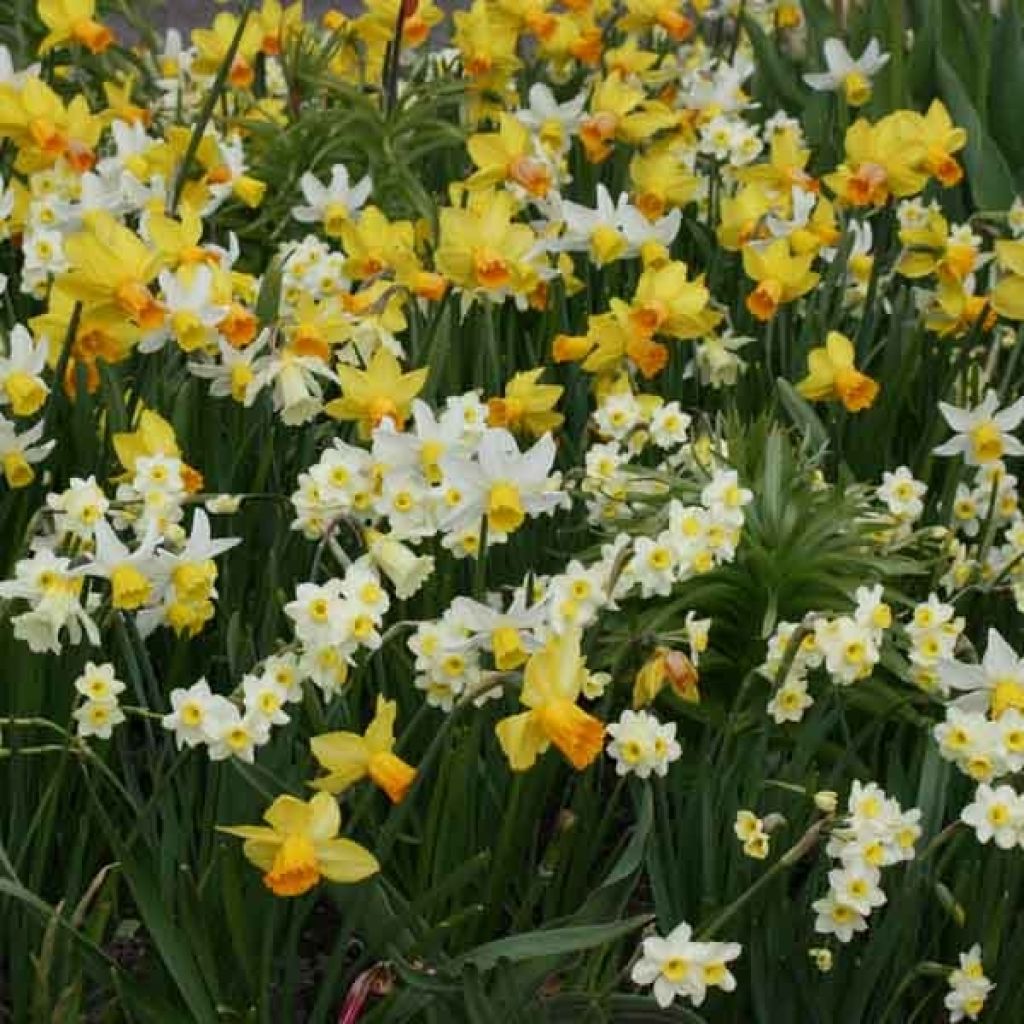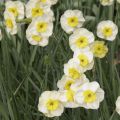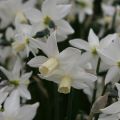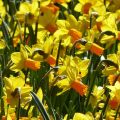

Collection of 45 Mini Daffodils
Collection of 45 Mini Daffodils
Narcissus Toto, Minnow, SunDisc, Jet Fire
This plant carries a 6 months recovery warranty
More information
We guarantee the quality of our plants for a full growing cycle, and will replace at our expense any plant that fails to recover under normal climatic and planting conditions.
From €5.90 for pickup delivery and €6.90 for home delivery
Express home delivery from €8.90.


Does this plant fit my garden?
Set up your Plantfit profile →
Collection items (45 plants)
Description
We offer you a collection of 50 Mini Daffodils with small flowers in different shades of cream, lemon yellow, white, yellow, and bright orange. Solid or two-tone, some very fragrant, all have been celebrated in England for their performance in the garden. Their flowering extends from February to April. All these bulbs - close to botanical species - are easy to grow, naturalise in well-drained soil, and establish themselves discreetly in the garden. Dwarf varieties are ideal for rockeries and containers.
The collection consists of:
10 Toto Daffodils: an old award-winning variety with a slightly curled white corolla and a small yellow trumpet turning cream.
15 Minnow Daffodils: multi-flowered, with up to 5 very small pale yellow to cream flowers with a small yellow trumpet on each stem. They are divinely fragrant, like all narcissus of the tazetta group.
10 SunDisc Daffodils
10 Jet Fire Daffodils: multi-flowered, with early and prolonged flowering, but also subtly fragrant. Small bright yellow blooms adorned with a small orange trumpet, full of life.
Labelled separately.
The genus Narcissus, from the Amaryllidaceae family, includes about 50 species mainly found in the Western Mediterranean, but also in Africa and Asia.
Undemanding, these daffodils grow in any well-drained and loosened soil, but results are diminished in soils that are too wet, especially in summer, or excessively acidic and dry. There is such a choice of varieties among daffodils that you can enjoy them for three months in spring without ever getting bored. They have in common the ability to naturalise easily, to produce lovely scenes of yellow and white, and often to emit sweet fragrances. For these reasons it is appealing to grow them in large clumps (at least 20 bulbs) for a multiplied effect. Combine daffodils in natural-looking beds and rockeries with squills, crocuses, and hyacinths, or accompany them with early-blooming botanical tulips as well as forget-me-nots, pansies, or liverworts. This daffodil is also perfect in pots.
Daffodil or Narcissus? Botanically speaking, daffodils are part of the narcissus family. They have flowers in groups of two or more, and their corolla forms a campanulate trumpet longer than it is wide. Botanical species have the charm of wild plants and thrive in rockeries: N. bulbocodium, N. canaliculatus, N. juncifolius and N. pseudonarcissus, the simple wood jonquil, are among the most beautiful. In bouquets, we advise you not to mix daffodils with other flowers such as tulips, as daffodil stems contain a substance that causes other flowers to wilt quickly. You can mitigate this harmful effect for other flower types by dipping the ends of the daffodil stems in warm water for 1 to 2 minutes.
Report an error about the product description
Plant habit
Flowering
Foliage
Botanical data
Narcissus
Toto, Minnow, SunDisc, Jet Fire
Amaryllidaceae
Cultivar or hybrid
Planting and care
Narcissi bloom from March to May and come back every year. Very easy to grow, they adapt to the shade of trees as well as to a sunny flowerbed. Plant them at a depth of 10 cm (4in) and spaced 10 cm (4in) apart. Group them in clusters of minimum 5 bulbs, in patches of uniform or mixed colours. You can plant them directly in the lawn: lift a section of turf, dig and loosen the soil to a depth of at least 20 cm (8in) (the depth of a spade). Plant your bulbs, cover with soil and reposition the grass turf. Choose a spot where you won't mow, as it's necessary to let the narcissus leaves wither before cutting them back - this is when the bulb regenerates and prepares the flowers for the following year. However do remember to cut the flowers off as soon as they fade, to prevent seed formation that would unnecessarily deplete the bulb.
Planting period
Intended location
Care
-
, onOrder confirmed
Reply from on Promesse de fleurs
Haven't found what you were looking for?
Hardiness is the lowest winter temperature a plant can endure without suffering serious damage or even dying. However, hardiness is affected by location (a sheltered area, such as a patio), protection (winter cover) and soil type (hardiness is improved by well-drained soil).

Photo Sharing Terms & Conditions
In order to encourage gardeners to interact and share their experiences, Promesse de fleurs offers various media enabling content to be uploaded onto its Site - in particular via the ‘Photo sharing’ module.
The User agrees to refrain from:
- Posting any content that is illegal, prejudicial, insulting, racist, inciteful to hatred, revisionist, contrary to public decency, that infringes on privacy or on the privacy rights of third parties, in particular the publicity rights of persons and goods, intellectual property rights, or the right to privacy.
- Submitting content on behalf of a third party;
- Impersonate the identity of a third party and/or publish any personal information about a third party;
In general, the User undertakes to refrain from any unethical behaviour.
All Content (in particular text, comments, files, images, photos, videos, creative works, etc.), which may be subject to property or intellectual property rights, image or other private rights, shall remain the property of the User, subject to the limited rights granted by the terms of the licence granted by Promesse de fleurs as stated below. Users are at liberty to publish or not to publish such Content on the Site, notably via the ‘Photo Sharing’ facility, and accept that this Content shall be made public and freely accessible, notably on the Internet.
Users further acknowledge, undertake to have ,and guarantee that they hold all necessary rights and permissions to publish such material on the Site, in particular with regard to the legislation in force pertaining to any privacy, property, intellectual property, image, or contractual rights, or rights of any other nature. By publishing such Content on the Site, Users acknowledge accepting full liability as publishers of the Content within the meaning of the law, and grant Promesse de fleurs, free of charge, an inclusive, worldwide licence for the said Content for the entire duration of its publication, including all reproduction, representation, up/downloading, displaying, performing, transmission, and storage rights.
Users also grant permission for their name to be linked to the Content and accept that this link may not always be made available.
By engaging in posting material, Users consent to their Content becoming automatically accessible on the Internet, in particular on other sites and/or blogs and/or web pages of the Promesse de fleurs site, including in particular social pages and the Promesse de fleurs catalogue.
Users may secure the removal of entrusted content free of charge by issuing a simple request via our contact form.
The flowering period indicated on our website applies to countries and regions located in USDA zone 8 (France, the United Kingdom, Ireland, the Netherlands, etc.)
It will vary according to where you live:
- In zones 9 to 10 (Italy, Spain, Greece, etc.), flowering will occur about 2 to 4 weeks earlier.
- In zones 6 to 7 (Germany, Poland, Slovenia, and lower mountainous regions), flowering will be delayed by 2 to 3 weeks.
- In zone 5 (Central Europe, Scandinavia), blooming will be delayed by 3 to 5 weeks.
In temperate climates, pruning of spring-flowering shrubs (forsythia, spireas, etc.) should be done just after flowering.
Pruning of summer-flowering shrubs (Indian Lilac, Perovskia, etc.) can be done in winter or spring.
In cold regions as well as with frost-sensitive plants, avoid pruning too early when severe frosts may still occur.
The planting period indicated on our website applies to countries and regions located in USDA zone 8 (France, United Kingdom, Ireland, Netherlands).
It will vary according to where you live:
- In Mediterranean zones (Marseille, Madrid, Milan, etc.), autumn and winter are the best planting periods.
- In continental zones (Strasbourg, Munich, Vienna, etc.), delay planting by 2 to 3 weeks in spring and bring it forward by 2 to 4 weeks in autumn.
- In mountainous regions (the Alps, Pyrenees, Carpathians, etc.), it is best to plant in late spring (May-June) or late summer (August-September).
The harvesting period indicated on our website applies to countries and regions in USDA zone 8 (France, England, Ireland, the Netherlands).
In colder areas (Scandinavia, Poland, Austria...) fruit and vegetable harvests are likely to be delayed by 3-4 weeks.
In warmer areas (Italy, Spain, Greece, etc.), harvesting will probably take place earlier, depending on weather conditions.
The sowing periods indicated on our website apply to countries and regions within USDA Zone 8 (France, UK, Ireland, Netherlands).
In colder areas (Scandinavia, Poland, Austria...), delay any outdoor sowing by 3-4 weeks, or sow under glass.
In warmer climes (Italy, Spain, Greece, etc.), bring outdoor sowing forward by a few weeks.







































